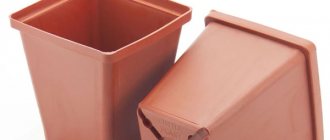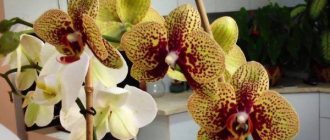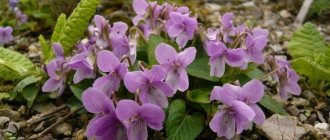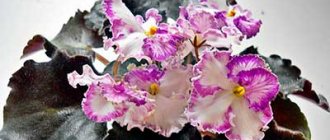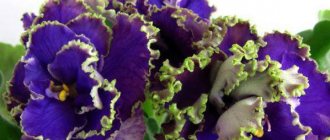Violets are considered one of the most common indoor flowers. The colors come in different colors, but two-color options are especially popular among gardeners. One of them is the Sunny Boy violet, which was bred by the famous Russian breeder Elena Vasilievna Korshunova.
Its flowers are known all over the world and are in great demand. Their diversity is simply amazing. A big plus is their rapid flowering, which can last most of the year.
What Saintpaulia Ness crinkle blue looks like
This variety of Saintpaulia stands out due to its external characteristics.
Stunning Saintpaulia Ness crinkle blue
It will be no less interesting to learn about the origin of the variety, as well as about other varieties from this group.
Description
Saintpaulia Ness crinkle blue is a semi-miniature variety. The size of the rosette, flowers and leaves is average. The plant is characterized by long flowering with breaks of 1-2 months.
The leaves are dark green, with a serrated edge and a sharp tip. The flowers are double, the petals are arranged in several layers. The color of the inflorescences is blue with a thin white rim around the edge. During flowering, the flower stalks bend under the weight of the inflorescences, lie on the rosette and almost completely cover it.
History of origin and species
Saintpaulias are also called Uzambara violets. Both names are related to the origin of the plant. The flowers were first noticed in the Uzambara Mountains region (Africa), and they were discovered by a local official, Saint-Paul Iller. He gave the seeds to one of the outstanding botanists of that time, Herman Wendland, who gave the flower the name Saintpaulia in honor of its discoverer. He also attributed the plant to the large family of Gesneriaceae.
The crinkle blue variety and many others were developed by breeder Don Nez. At first, he was engaged in crossing gloxinias as a hobby, and became interested in Saintpaulias after visiting an exhibition of Uzambara violets in Sao Paulo. The selection was so successful that the new varieties spread throughout the continent and soon gained worldwide fame.
Features and characteristics of Ness varieties
Violet Humako inches - plant features
As a result of many years of work, Don Ness gave the world many varieties of Saintpaulia. Some of them deserve special attention. For example, such as Uzambara violet Ness orange pekoe or antique red.
Crinkle Blue
It is distinguished by almost continuous flowering. Double flowers resemble miniature blue roses. Violet is very unpretentious and easy to grow.
Crinkle blue
Orange Pekoe
Usambara violet Ness Orange Pekoe has double or semi-double flowers in a deep coral shade.
Orange Pekoe
The inflorescences look very decorative against the background of creamy-green and sometimes green-pink leaves.
Satin Rose
Double flowers with a delicate white-lilac color that changes from the middle to the edge.
Satin Rose
The peculiarity of the variety is the coronal arrangement of inflorescences. The leaves have pronounced ribbing and a serrated edge.
Spring Blush
Single and semi-double flowers consist of white petals with soft pink stripes and purple spots.
Spring Blush
Saintpaulia breeders call this color a chimera. The plant is very easy to care for and has long and abundant flowering.
Blueberry Puff
The blue flowers of this variety seem to be decorated with white specks of paint. Outwardly, it looks like the glare of sunbeams on the petals. The inflorescences are dense, up to 15 flowers can be collected on one.
Blueberry Puff
Tiny Flame
Delicate purple double or semi-double flowers contrast against the background of dark foliage.
Tiny Flame
The peculiarity of the variety is a creamy white border along the edge of the leaves.
Pink Confetti
This compact variety of Saintpaulias has original flower colors.
Pink Confetti
The white petals around the edges seem to be covered with splashes of fuchsia paint.
Red Velvet
The flowers are simple, with wavy edges of the petals.
Red Velvet
The velvety scarlet color becomes slightly lighter from the middle to the edge. Violet is easy to care for and simply reproduces.
Angel Face
The flowers are shaped like miniature bells.
Angel Face
Petals with a slight waviness along the edge have a fuchsia tint.
Antique Red
Against the background of dark green foliage, double flowers of rich red color, similar in shape to miniature roses, stand out brightly. Violet blooms almost all year round.
Antique Red
Up to 7 flowers bloom simultaneously on one peduncle.
Fantasy Gold
The color of double flowers simultaneously contains yellow, pink and fuchsia shades.
Fantasy Gold
On each petal they are combined randomly. The leaves are deep green, almost black.
Blueberry Kiss
The variety is distinguished by large flowers of original color.
Blueberry Kiss
The snow-white center turns into the blue edges of the petals. Violet blooms for more than 6 months. The inflorescences form very large.
Description of violet Sunny boy with photos
Violet Sunny Boy - these are flowers with large lemon-white petals, bordered by a blue fringe, with a yellow center and a blue eye. The outlet itself is small. The predominant color is lemon. The shape of the flower resembles a pompom and the size is 6 cm.
The flowers are located so close to each other that together they form a fluffy ball consisting of buds and peduncles, on which there are 5-6 flowers. If the flower is placed in a place with high temperature, blue marks may appear.
The leaves of the plant are green and wavy. It often happens that violet blooms without any yellow color at all, but with age it begins to appear more and more. Often it is the description and photo of a flower that pushes flower growers to grow it.
The main thing is to make sure that there is not a lot of blue, otherwise the violet will go to waste. The typical violet coloring begins to appear after 2-3 blooms. As practice shows, if a plant initially blooms with a pure color, it is not in danger of being darkened by blue.
The Sunny Boy variety is characterized by a rather long blooming of flowers, and this happens alternately. A distinctive feature of this variety of violets is that it begins to bloom quite early - at 10 months
Features of care
Saintpaulias are unpretentious indoor flowers. To admire the beautiful blooms almost all year round, it is enough to follow a few rules regarding care and maintenance:
- Watering is carried out in the pan. To do this, use settled water at room temperature.
- The temperature is maintained at 20-23 °C, the main thing is not lower than 18 °C.
- Lighting is necessary for a long time and intense, but not direct sunlight.
- It is better to purchase ready-made soil, especially for Saintpaulias.
- Mineral fertilizing is applied in the spring and summer, once every 10-14 days.
Violet VaT Tsar Peas - plant features
Caring for Saintpaulias is quite simple. The main thing is to prevent the soil from becoming waterlogged and to provide the plants with good lighting.
Attention! Spraying and wiping leaves is strictly prohibited. To maintain humidity, it is recommended to place the pot on a tray with damp pebbles or expanded clay.
How to care for flowers
Like all other varieties of violets, Sunny Boy is not too whimsical, but certain rules must be followed in its cultivation. This is especially important for those who want to get a beautiful and original violet.
It should be borne in mind that this flower loves a lot of light, but this does not mean that the plant should be placed in direct sunlight. Sufficient humidity is very important for violets. However, the plant will not tolerate stagnation of water in the soil, which will certainly affect its color and can cause the development of diseases.
Sunny Boy does not tolerate spraying, so such a procedure should be excluded. Water the plant exclusively with warm and settled water. For the violet root system, watering through a tray is considered especially useful.
Important. The sunny boy needs to be protected from drafts. The violet also tolerates overheating and dry air very hard, so you should not place the pot next to a heater, radiator or fan.
Periodically, you can add fertilizer to the soil and replant the bush, if necessary. With proper care for the Sunny Boy, within a year he will begin to delight his caring owner with the most beautiful flowers.
Violet Sunny Boy is sensitive to watering regime.
It should be borne in mind that the flowering of the rosette can last up to 2 months, after which the plant takes a short break. All faded flowers should be removed in time to give the violet strength to develop new ones.
In order for Sunny Boy to please with beautiful pedigree flowers and not produce rosettes of the wrong shades, you need to follow the main rule in care. It concerns watering. If the plant is over-watered, it will not only bloom poorly, but may also become diseased.
Violets are susceptible to some dangerous ailments and are afraid of parasites, so preventive measures regarding such flowers will not be superfluous.
Reproduction
What is the name of violet pink, blue, purple and others
Most often, Saintpaulias are propagated by leaf cuttings. Only healthy and not too young leaves should be used.
Procedure:
- The cuttings are placed in water until roots appear.
- Then it must be rooted in a substrate of peat and sand mixed in a 2/1 ratio.
- After 2-3 leaves appear, they are picked into separate pots.
Propagation by leaf cuttings - quick and easy
For large plants, when replanting, the method of dividing the bush is used. Propagation by seeds is a rather labor-intensive and time-consuming process, which is only relevant for obtaining plants of a rare variety.
Attention! To get seeds yourself, you need to carry out artificial pollination of flowers.
Transplantation after purchase and during reproduction
Transplantation work is carried out by transshipment - so as not to damage the root system. The pot should be 2/3 the size of the flower. The bottom is lined with drainage and a layer of new soil. After moving the violet, the voids are covered with earth.
Important! Replanting after purchase is mandatory - plants from stores are in a poor soil mixture, without the required amount of nutrients.
When propagating, leaves with roots need to be rooted in the ground and watered. You can make a greenhouse out of film to accelerate the growth and development of a flower. After the baby is formed, the plants are sent to a permanent pot and transferred to the windowsill.
When and how does it bloom
Saintpaulia or violet, Ness crinkle blue has a very long flowering period. Almost all year round the rosette is covered with lush double inflorescences.
During the flowering period, the plant must be properly cared for. Fertilizing should be done at least once every 10 days. It is necessary to prevent temperature changes and protect the flower from drafts.
Important! Under no circumstances should you move a blooming Saintpaulia to another place. During this period the plant is very sensitive.
Possible problems during cultivation
The reasons for the deterioration in the appearance of Saintpaulia can be improper care, attack by pests or diseases.
Improper care
Errors in care include excessive watering, non-compliance with light and temperature conditions. Signs that the plant is experiencing discomfort include the appearance of spots on the leaves or their wilting.
Pests and diseases
Usambara violet Ness Crinkle Blue is susceptible to a number of diseases, such as late blight, fusarium, powdery mildew and various rots. The most common parasites of the plant are aphids and cyclamen mites. At the first signs of damage to the flower, the leaves and soil should be treated, and sometimes transplanted into another pot.
Saintpaulias - flowering and unpretentious plants
Saintpaulia Ness crinkle blue is a beautiful variety presented to the world by breeder Don Ness. His name is also given to such species as Uzambara violet orange pekoe, satin rose and many others. If you follow simple rules for care and maintenance, these unpretentious flowers will delight you with beautiful blooms almost all year round.
Feeding and replanting violets Sunny boy
To obtain high-quality and lush color of the Sunny Boy, it is recommended to apply fertilizers. This procedure should not be performed too often. Those gardeners who abuse fertilizing can simply destroy a beautiful flower.
It is important to consider that the soil for violets must be correct. It is best to take special substrates that are sold in flower shops. They contain components in optimal proportions. But if you wish, you can make the soil mixture yourself.
For this, peat, sphagnum moss, leaf soil, sand and charcoal are taken. It should be borne in mind that all these components must be properly processed so as not to introduce pests or diseases. The substrate for the Sunny Boy should contain at least 30% moss and coal. The least amount of sand is added.
For better plant growth, experts recommend adding perlite to the soil. It will better retain moisture in lightweight soil. Regardless of the composition of the soil for violets, humate must be added to it once a year.
In order for the Sunny Boy violet to bloom profusely and luxuriantly, it is periodically fed with fertilizers.
In autumn and spring, mineral fertilizers are also used. For the sunny boy, as for other varieties of Saintpaulia, liquid mineral fertilizers are suitable.
There are a lot of nuances to follow when growing violets. It is advisable to pay special attention to the earthen coma. It must be sufficient for the roots to develop normally. However, in a very large pot the flower will not feel well, so such planting is unacceptable.
In any case, someday it will come to a transplant.
In this case, the following features must be taken into account:
- You should prepare the right pot and be sure to stock up on a sufficient amount of fresh substrate. It is believed that for an adult violet a pot 10-12 cm high is sufficient. And a third of this volume should consist of drainage filler. This is important for proper violet flowering. Until the root system fills the entire space with soil, you should not expect flowers.
- When planting, be sure to pay attention to the drainage hole. It should be large enough so that water does not linger in the soil. Otherwise, the violet will hurt.
- During transplantation, you should inspect the roots of the violet.
When replanting, you need to pay attention to what kind of roots the plant will have. In a healthy Sunny boy they are light and completely fill the space of the pot. If you remove the plant, the root system will retain its shape. Diseased roots will be immediately visible by color and appearance. When transplanting, they must be removed.
- For the Sunny Boy violet, the correct temperature is very important. Particular attention should be paid to the temperature regime during the first weeks after transplantation. For summer, the best option would be 25 degrees, and for winter, 20 is enough. Air humidity for good flowering should be 50%.
